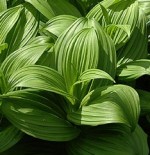 False hellebore, also known as Indian and American hellebore, is a herbaceous perennial and a member of the Melanthiaceae family that also includes Trillium. It is native to eastern and western North America and grows in wet woods and swamps from Canada to the Carolinas but is also found in Alaska, and the mountains of Idaho, Oregon, and Washington. False hellebore is not even distantly related to the other plants more commonly known as hellebores that include Christmas hellebore, Lenten rose, and stinking hellebore. False hellebore is poisonous while true hellebores are not.
False hellebore, also known as Indian and American hellebore, is a herbaceous perennial and a member of the Melanthiaceae family that also includes Trillium. It is native to eastern and western North America and grows in wet woods and swamps from Canada to the Carolinas but is also found in Alaska, and the mountains of Idaho, Oregon, and Washington. False hellebore is not even distantly related to the other plants more commonly known as hellebores that include Christmas hellebore, Lenten rose, and stinking hellebore. False hellebore is poisonous while true hellebores are not.
Description: False hellebore grows 2-8′ tall from a thick rootstock and has a leafy, hairy stem bearing light green foliage. The leaves are oval, heavily ribbed, and up to 12″ long , and have hairy undersides. The small greenish white to greenish yellow flowers are hairy and borne in dense branching terminal panicles up to 12″ long. They appear in summer and give way to capsules that are straw-colored to dark brown.
Poisonous Properties: All parts of false hellebore are poisonous with the greatest toxicity occurring in the inner rhizome. Alkaloids contained in the plant include germidine, germitrine, veratridine, veratrosine, and veratramine. Although extracts from false hellebore have been medicinally to treat conditions such as hypertensive toxemia during pregnancy and some dire cases of pulmonary edema, misuse of medicinal preparations accounts for most of the instances of poisoning in humans. Symptoms include burning in the mouth and throat, abdominal pain, nausea, diarrhea, sweating, impaired vision, hallucinations, headache, loss of consciousness, paralysis, and sometimes death. The effects of ingesting it are slow to show themselves but symptoms usually disappear within 24 hours.